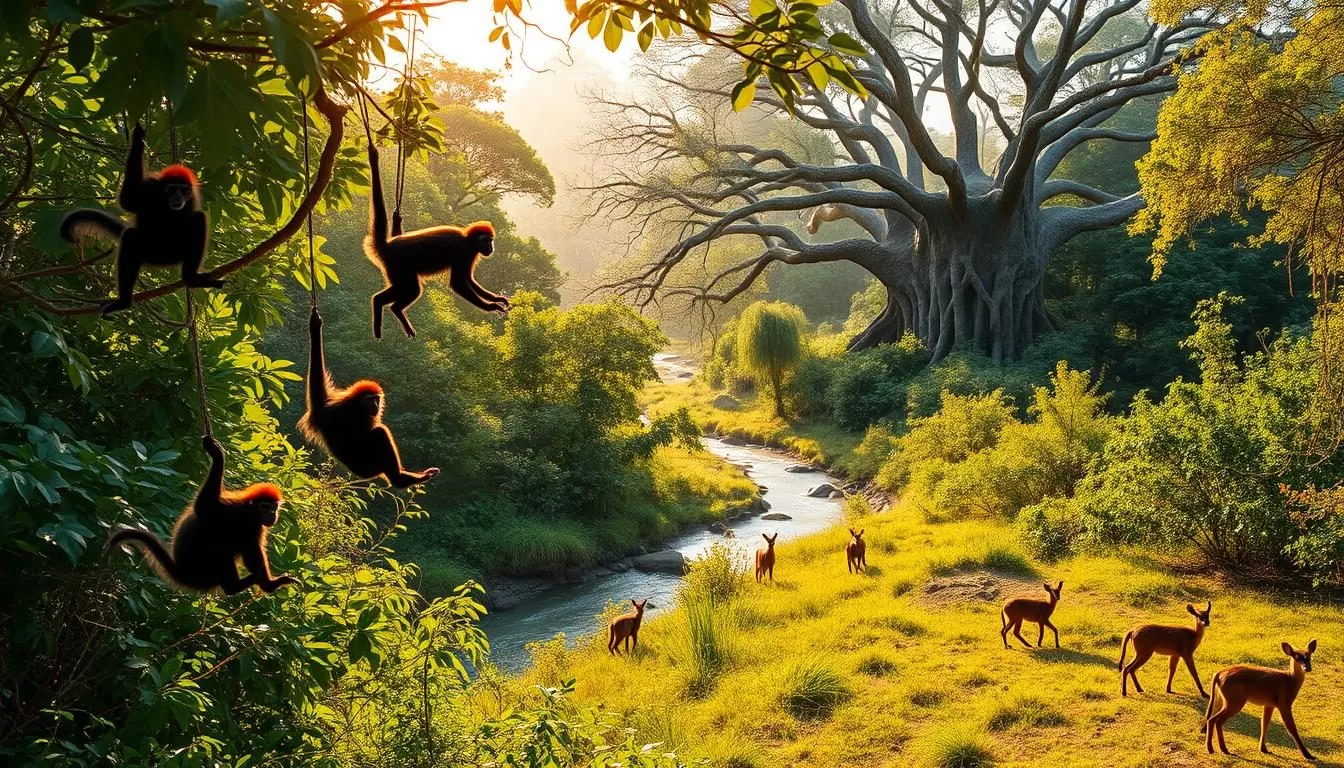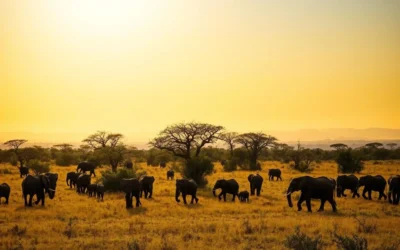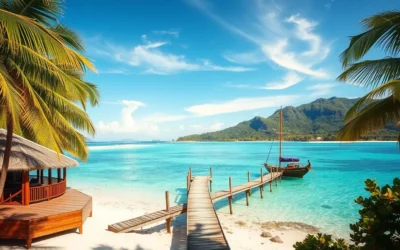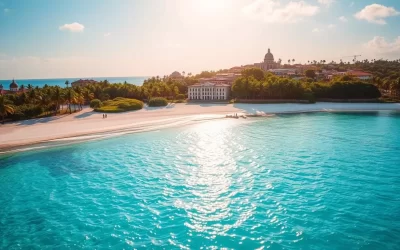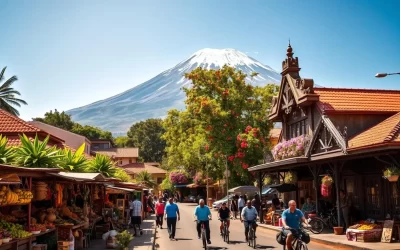✓ Accommodations✓ Flights✓ Rental Cars
Are you ready to explore Zanzibar’s only national park and a biodiversity hotspot? Jozani-Chwaka Bay National Park is a must-visit destination for wildlife enthusiasts and nature lovers.
The park is home to the endangered Zanzibar red colobus monkey, a species found nowhere else in the world. As you venture into the park, you’ll discover a diverse ecosystem spanning mangrove forests, tropical rainforests, and coastal areas that support a rich variety of flora and fauna.
This guide will walk you through the best activities and experiences in the park, from wildlife spotting to guided nature walks. Whether you’re a nature lover, photographer, or family looking for an educational experience, Jozani-Chwaka Bay National Park offers something special for every visitor.
Discovering Jozani-Chwaka Bay National Park
As you step into Jozani-Chwaka Bay National Park, you’re entering a world where conservation efforts and natural beauty blend seamlessly. The park is a haven for wildlife and a testament to the importance of protecting our natural environment.
Location and Overview
Jozani-Chwaka Bay National Park is located on the island of Zanzibar, Tanzania. It is the first and only national park on the archipelago, making it a unique destination for nature lovers and those interested in conservation.
Conservation Significance
The park plays a crucial role in protecting Zanzibar’s unique flora and fauna, particularly the critically endangered Zanzibar red colobus monkey. Some key aspects of the park’s conservation significance include:
- Protecting the natural habitat of endemic species
- Supporting conservation efforts that have helped increase the population of the Zanzibar red colobus monkey
- Promoting community involvement in conservation initiatives
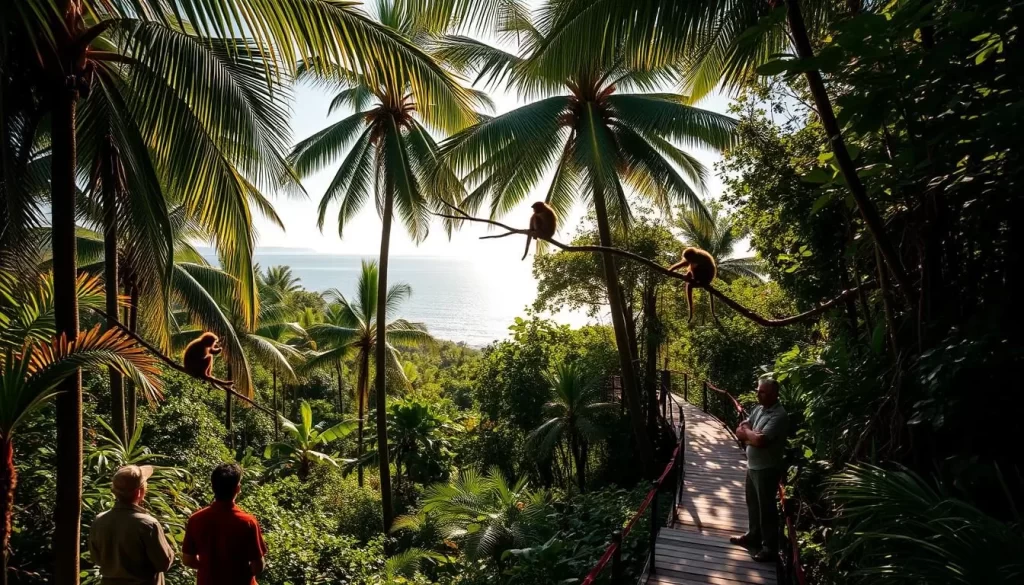
Planning Your Visit to Jozani-Chwaka Bay National Park
A well-planned visit to Jozani-Chwaka Bay National Park can significantly enhance your overall experience in this Tanzanian paradise. To make the most out of your trip, consider the essential aspects of planning.
Best Time to Visit
The best time to visit Jozani-Chwaka Bay National Park is during the dry season, which typically runs from June to October. The weather is generally dry and sunny, making it ideal for exploring the park’s lush forests and spotting wildlife, including the endangered Zanzibar Red Colobus monkeys.
How to Get There
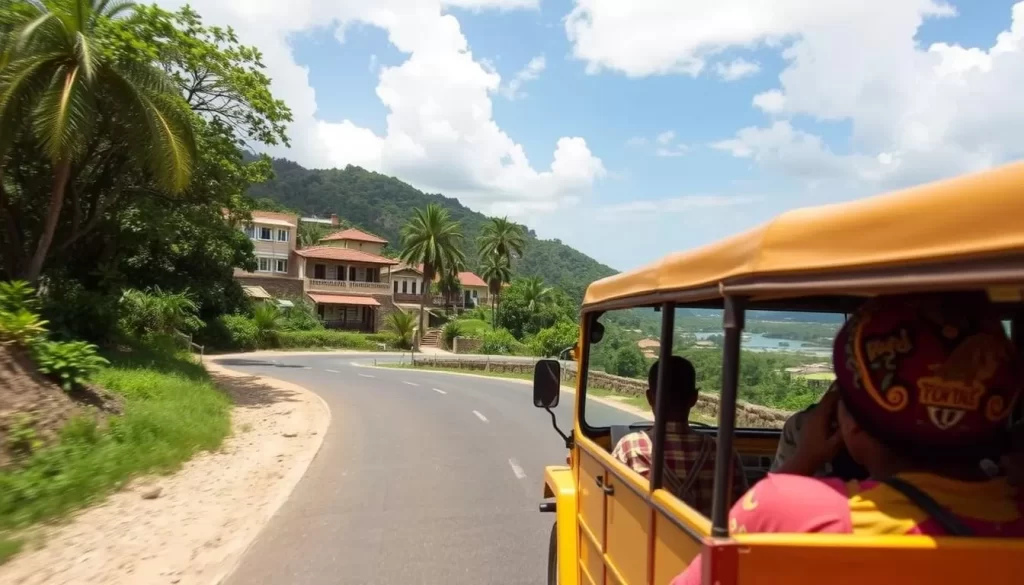
Jozani-Chwaka Bay National Park is easily accessible from Stone Town, a distance of approximately 30 kilometers, which takes around 35-40 minutes by car. You can also use public transportation like dala-dalas (local minibuses) or take a taxi for a more direct trip. Many hotels and tour operators in Zanzibar offer organized day trips to the park, including transportation and guided tours.
If you’re staying on the east coast of Zanzibar, the park is even closer, just a 15-20 minute drive from popular areas like Paje and Jambiani, making it a convenient visit to Jozani for those staying in various parts of the island.
Meet the Endangered Zanzibar Red Colobus Monkeys
The Zanzibar red colobus monkeys, endemic to Zanzibar, are a must-see when visiting Jozani-Chwaka Bay National Park. These charismatic primates inhabit the forests of the park, offering a unique experience for visitors.
About This Unique Species
The Zanzibar red colobus is an endangered species found only in the forests of Jozani Chwaka Bay National Park. This unique species is known for its distinctive coloring and expressive faces.
Best Viewing Spots and Photography Tips
To spot the red colobus monkeys, head to the forest edge near the main trail entrance, especially during morning hours when they feed. Here are some tips for viewing and photographing them:
- The forest edge offers excellent viewing opportunities as the monkeys feed in this area.
- Bring a zoom lens (70-300mm is ideal) for close-up shots without disturbing the colobus monkey.
- Capture their expressive faces and distinctive coloring, utilizing early morning light for beautiful natural lighting.
- Park guides can lead you to current hotspots where troops are feeding or resting, enhancing your experience with the monkeys.
- Maintain a respectful distance of at least 10 meters to protect both the animals and visitors.
Guided Forest Tours and Nature Walks
To truly experience the essence of Jozani-Chwaka Bay National Park, consider joining a guided forest tour. These tours offer a unique opportunity to discover the park’s natural beauty and gain insights into its ecological significance.
What to Expect on a Guided Tour
On a guided tour, you’ll explore the forest with a knowledgeable local guide who will lead you to hidden treasures and unexpected wildlife sightings. You’ll gain a deeper understanding of the park’s ecosystem and the importance of conservation efforts.
Benefits of Hiring a Local Guide
The benefits of hiring a local guide include:
- Extensive knowledge of the forest’s hidden treasures and wildlife
- Deeper insights into the park’s ecological and cultural significance
- Support for community employment and sustainable tourism
- Enhanced safety and responsible wildlife viewing practices
- A personalized experience that creates lasting memories
By hiring a local guide, you’ll not only enhance your experience but also contribute to the local community’s well-being.
Exploring the Mangrove Boardwalk
As you step onto the mangrove boardwalk at Jozani-Chwaka Bay National Park, you’re about to embark on a journey through one of Tanzania’s most unique ecosystems. The mangrove forests here are not just visually stunning, but they are also teeming with life, hosting a variety of species that are adapted to this specific environment.
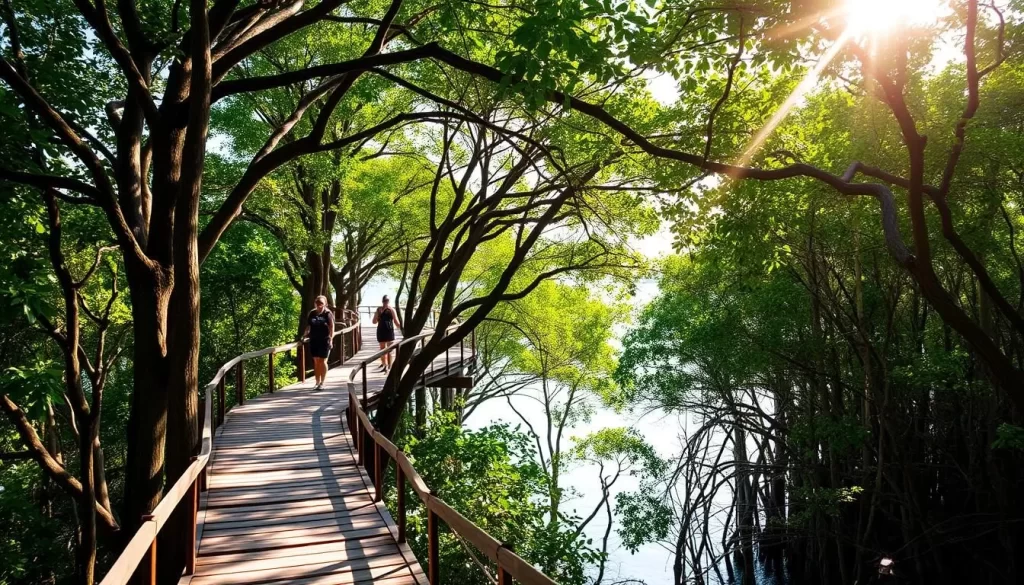
The Unique Mangrove Ecosystem
The mangrove ecosystem at Jozani-Chwaka Bay is characterized by its rich biodiversity. The mangroves support a complex web of life, from the trees themselves to the myriad creatures that live among their roots and branches.
The ecosystem is home to a variety of crabs, including the colorful fiddler crabs, which are easily spotted scurrying across the mud at low tide with their distinctive asymmetrical claws.
Wildlife Spotting Opportunities
As you walk along the boardwalk, look carefully among the mangrove roots for mudskippers—fascinating amphibious fish that can breathe air and “walk” on their modified pectoral fins. The mangroves are also a haven for birdwatchers, with species such as kingfishers, herons, and the elusive mangrove kingfisher with its brilliant blue plumage.
- The interconnected waterways serve as highways for various marine creatures, including small fish, shrimp, and even juvenile eels.
- Your guide will help you identify the subtle signs of wildlife presence, from tracks in the mud to feeding marks on leaves, revealing the hidden biodiversity of this seemingly quiet ecosystem.
Other Wildlife Encounters in Jozani-Chwaka Bay National Park
Beyond the Zanzibar Red Colobus, Jozani-Chwaka Bay National Park is teeming with other fascinating wildlife. The park’s diverse ecosystem supports a wide range of species, ensuring that visitors have a rich and varied experience.
Sykes’ Monkeys and Other Primates
In addition to the Zanzibar Red Colobus, the park is home to Sykes’ monkeys, another primate species that inhabits the forest canopy. These agile creatures are a delight to watch as they navigate the trees with ease.
Rare and Endemic Species
Jozani-Chwaka Bay National Park is also a sanctuary for several rare and endemic species. Some of the elusive creatures found here include Aders’ duikers, tiny antelopes that inhabit the dense undergrowth, and sunis, small antelopes that stand just 12-16 inches tall. Nocturnal civets and shy bushpigs are also residents of this ecosystem. Moreover, the critically endangered Zanzibar leopard is believed to inhabit the remote parts of the park, although sightings are extremely rare. Tree hyraxes, relatives of elephants, can be heard calling loudly at night from the forest canopy.
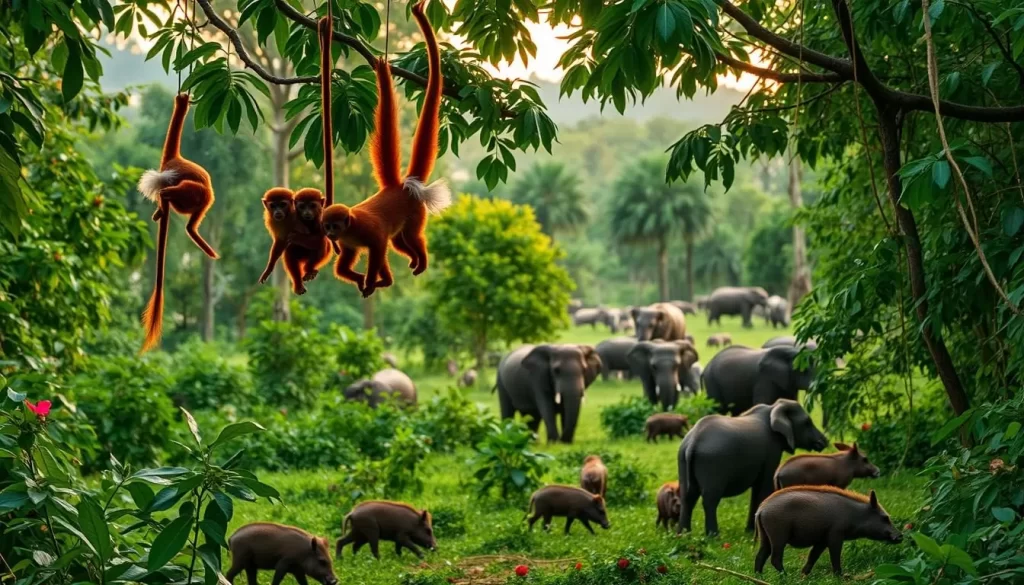
Birdwatching Paradise: Top Species to Spot
With its unique ecosystem, Jozani-Chwaka Bay National Park attracts a wide variety of birdlife, making it a birdwatcher’s dream destination. As you explore the park, you’ll have the opportunity to spot numerous species, from vibrant kingfishers to majestic eagles.
Common and Rare Bird Species
The park is home to a diverse range of bird species, including the African Paradise Flycatcher, Fischer’s Turaco, and the Malachite Kingfisher. You may also catch a glimpse of the elusive Sokoke Scops Owl or the Palm-nut Vulture soaring overhead.
| Bird Species | Description | Habitat |
|---|---|---|
| African Paradise Flycatcher | Known for its long tail feathers and acrobatic flight | Forest edges and clearings |
| Fischer’s Turaco | Vibrant plumage with bright red, green, and blue feathers | Forest canopy |
| Malachite Kingfisher | Iridescent blue and green plumage, hunting for fish near water edges | Water bodies and mangrove areas |
Best Locations for Birdwatching
The forest edge areas, mangrove boardwalk, and freshwater pools are ideal locations for birdwatching. Early morning visits between 6:30-9:00 AM yield the best results, as most species are actively feeding and calling during this time. Bringing binoculars (8×42 or 10×42 magnification is ideal) will enhance your birdwatching experience.
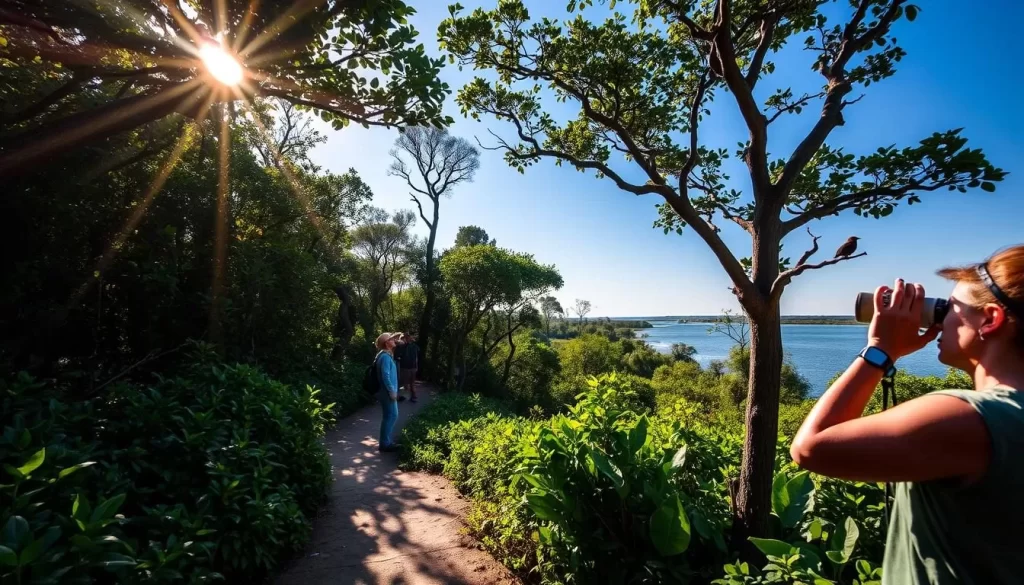
Jozani-Chwaka Bay National Park, Tanzania: Best Things to Do – Top Picks
Jozani-Chwaka Bay National Park offers a diverse range of experiences, from exploring lush forests to venturing into underground caves. As you visit this beautiful park on the island of Zanzibar, you’ll have the opportunity to engage in various activities that showcase its natural beauty and unique wildlife.
Butterfly Garden Visit
A visit to the butterfly garden is a serene experience, surrounded by the beauty of nature. The garden is home to a variety of butterfly species, offering a tranquil atmosphere for visitors. You can observe these delicate creatures up close, learning about their life cycle and the importance of conservation efforts.
Cave Exploration
Exploring the caves near Jozani-Chwaka Bay National Park is an adventure like no other. The limestone caves offer a glimpse into the geological history of the area, with formations that have taken thousands of years to develop. Guided tours ensure that you experience the caves safely while learning about their significance.
| Activity | Description | Highlights |
|---|---|---|
| Butterfly Garden Visit | A serene experience surrounded by nature | Variety of butterfly species, tranquil atmosphere |
| Cave Exploration | Adventure into limestone caves | Geological formations, guided tours |
Visitors to Jozani-Chwaka Bay National Park can enjoy a range of experiences, from the tranquility of the butterfly garden to the adventure of cave exploration. Each activity provides a unique perspective on the park’s natural beauty and conservation efforts.
Natural Landscapes and Scenic Spots
Visitors to Jozani-Chwaka Bay National Park are treated to a visual feast of natural landscapes, from lush forests to tranquil wetlands. The park’s diverse geography creates a multitude of scenic spots that are perfect for exploration and relaxation.
Forest Canopy Views
One of the park’s most striking features is its forest canopy, offering breathtaking views from elevated vantage points. The dense foliage creates a vibrant ecosystem, teeming with life. As you walk through the forest, the canopy above provides a natural spectacle, with sunlight filtering through the leaves to create dappled patterns on the forest floor.
Freshwater Ponds and Wetlands
The freshwater ponds and wetlands within Jozani-Chwaka Bay National Park are havens for wildlife and offer serene landscapes. These areas are rich in biodiversity, supporting a variety of plant and animal life. You can observe the unique ecosystems up close, with water lilies floating on the ponds and various species of birds and insects inhabiting the wetlands.
- The ponds serve as vital water sources for wildlife, especially during dry periods.
- These wetland areas are rich in biodiversity, supporting plants like water lilies and habitat for frogs, freshwater crabs, and various insects.
- The ponds create stunning photo opportunities, reflecting the surrounding forest and sky.
Cultural Experiences Near the Park
To ensure a rich cultural experience during your trip, consider exploring the local villages and learning about conservation efforts near Jozani-Chwaka Bay National Park. As visitors, you’re encouraged to follow guidelines that support the local community and the park’s ecosystem.
Visiting Local Villages
You’ll have the opportunity to visit local villages where you can witness the traditional Tanzanian way of life. This experience allows you to engage with the community and understand their daily lives and conservation efforts.
Learning About Local Conservation Efforts
The park’s conservation success story involves community-based approaches, including a revenue-sharing model that benefits local communities. You’ll learn about these initiatives and how they contribute to the preservation of the park’s ecosystem, enhancing your overall experience.
Practical Tips for Visitors
As you plan your trip to Jozani-Chwaka Bay National Park, consider these practical tips to make the most of your visit.
What to Bring
When visiting the park, it’s essential to bring comfortable walking shoes, water, and binoculars to enhance your experience. Don’t forget to pack sun protection and insect repellent to ensure your comfort while exploring the natural environment.
Responsible Tourism Guidelines
To preserve the park’s delicate ecosystem, stay on designated trails and keep noise levels low. Visitors should also avoid feeding or touching wildlife, especially the endangered Zanzibar red colobus monkeys. Additionally, take all trash with you when leaving, and support conservation by paying the required entrance fees willingly.
Conclusion
Discover the heart of Zanzibar’s natural heritage at Jozani-Chwaka Bay National Park. Your visit supports conservation efforts protecting endangered species like the Zanzibar red colobus monkey. With diverse ecosystems, it’s a complete nature experience that complements Zanzibar’s famous beaches and cultural attractions.
Plan your trip to fully appreciate the park’s biodiversity and consider combining it with other nearby attractions for a well-rounded Zanzibar experience.
The above is subject to change.
Check back often to TRAVEL.COM for the latest travel tips and deals.
